Here’s everything you should know if you need to remove black algae from your pool…
There are a dizzying number of contaminants that could obliterate the crystal-clear cleanliness of your backyard swimming pool. One of the worst is black algae.
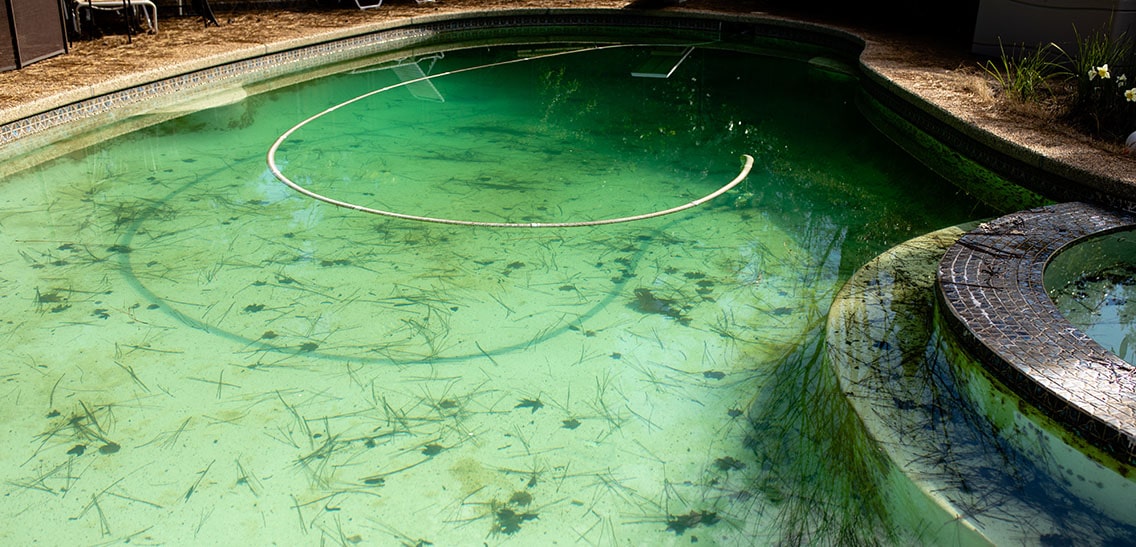
This means that if you see it in your pool, you’ve got some serious work ahead of you. In this article, you’ll learn what the tell-tale signs of black algae are, the10 steps you must take to get rid of it, and how to prevent it from returning.
Let’s dive in!
What’s Black Algae?
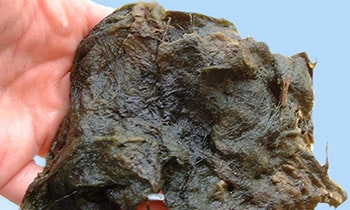
Algae is a type of aquatic plant and can be everything from tiny single-celled organisms to seaweed. Like most other plants on the face of the planet, green algae uses chlorophyll to perform photosynthesis, the process by which plants use to manufacture food from carbon dioxide and water.
Black algae isn’t really algae — it’s a single cell organism known as cyanobacteria. It’s blue-green in color but appears black because it contains other water-soluble pigments that combine with blue-green to make it appear black. It can inhabit fresh- and saltwater, as well as damp soil and rocks.
What’s It Doing in My Pool?
If you’re recently taken a dip in the ocean, a lake, or other natural body of water and then jumped into your pool, you’re at risk of introducing black algae to it. From chic bathing suits to swim-happy pets, black algae has a whole host of vehicles it can use to hitch a ride to your backyard swimming hole. It’s way easier to transfer from a pond or lake than you probably ever realized.
A black algae infestation can happen if someone uses a pool float in a lake or the ocean without spraying it off thoroughly with a garden hose. The aquatic pest can even get into your pool if airborne spores of the species happen to be wafting your way (although this is an exceedingly rare occurrence).
How Harmful is It?
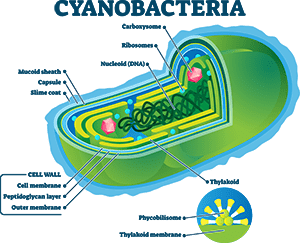
Black algae thrive on the surfaces of natural bodies of water and is most common in the sweltering summer months. In the wild, cyanobacteria proliferates so much, it destroys other life forms by blocking life-giving sunlight and stealing nutrients such as oxygen. However, its growth won’t get this extreme in your pool.
However, it can still hurt you. Cyanobacteria manufacture cyanotoxins, which are potent natural poisons. It can make you, your family, your pets, and anyone else who takes a dip in your backyard swimming pool deathly ill. Just swimming in black algae-infested water for even a short time can make you sick.
The virulent toxins cyanobacteria produce can cause the wholesale contamination of municipal water supplies. The risk of contracting life-threatening symptoms increases dramatically if you accidentally drink water tainted with the stuff. If you do, it can cause liver damage, paralysis, or even death.
How to Recognize Black Algae
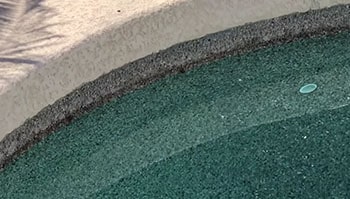
To keep you and your family safe, you’re going to need to be able to identify black algae as soon as it rears its ugly head. Then, you’ll need to take decisive action to get rid of it.
Cyanobacteria looks like a bunch of tiny black dots or huge mold clumps with raised heads that adhere to surfaces (it’s not free-floating). It may appear more blue-green than black. You’ll often find black algae in areas such as along a wall, in the deep end, in a corner, or around steps or ladders. These are usually areas of your pool where the circulation is poor. This means little or no freshwater, algaecide, or sanitizer gets there.
You won’t find it as much in pools with vinyl or fiberglass liners. Instead, it prefers rough surfaces such as concrete, gunite, or plaster pools because they have porous surfaces the organism can stick to. The bacteria even shoots its roots down into cracks, making it even harder to eradicate.
How To Kill Black Algae in 10 Steps
You’ll fail if you treat cyanobacteria like garden-variety green algae. If you ever hope to annihilate this aqueous menace, you’re going to need to up your game. Before you start the black algae eradication process, you’ll need:
- backwash hose (if necessary)
- filter sand (if required)
- DE powder (if needed)
- replacement filter cartridge (if required)
- filter cleaner
- test strips or liquid test kit
- algae brush
- chemical-resistant gloves
- safety goggles
- chlorine tablets
- chlorine tablet holder
- telescoping pole
- calcium hypochlorite shock
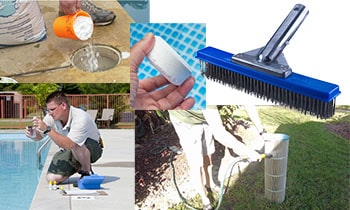
1. Clean the Filter
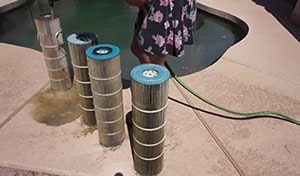
If black algae is in your pool water, it also infiltrated your filter. However, if there’s only a tiny amount of it in your pool, you might be able to get away with only backwashing your filter or giving the filter cartridge a good rinse.
Since black algae can be a formidable opponent, you should probably just go ahead and replace the filter medium or cartridge.
That way, you’ll know that your filter is blessedly free of the threat.
2. Test and Balance the Water
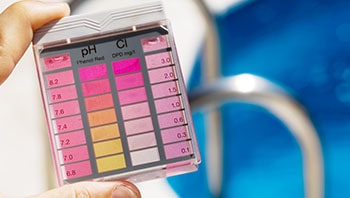
Make sure the chemical balance of your pool water is at its optimal level. This way, you’ll know precisely how much pool shock to use. Use either a liquid test kit or test strips. Don’t worry about calcium hardness—focus on pH, alkalinity, and sanitizer.
Here’s where the levels should be:
- alkalinity: 100 ppm to 150 ppm (125 ppm is optimal)
- pH: 7.4 to 7.6
- chlorine: 1 ppm to 3 ppm
How to Raise pH in Pool
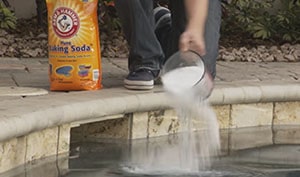
If you find out the pH level of your pool is low, there are a couple of things you can do to raise it:
- Add Soda ASH: Soda ash or sodium bicarbonate have lots of alkalinity, easily dissolve in water, and don’t leave much of a trace. Adding either of them will decrease acidity and raise pH levels of your pool water.
- Aerate The Water: This can be done by pointing water jets towards the pool surface, by turning on water features, or adding aeration pipes. However, doing this is a lengthy process, and can take days.
3. Brush the Pool
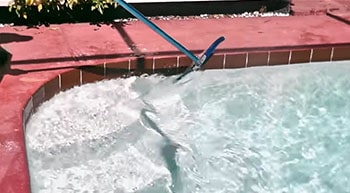
To defeat this nasty foe, you’re going to need to buy a stainless-steel algae brush. It’s specially designed to scrub away algae and works well with cyanobacteria, even though it’s not really algae. If you have a vinyl or fiberglass liner, use a nylon-bristled brush.
Scrub as vigorously as you can because black algae has deep roots that can penetrate deep into crevices. Just because you can’t see it doesn’t mean it’s gone.
Get into the cracks, so you scrub away all the spores hiding there. This should loosen the black algae from the pool surfaces so it can float in the water, where the shock will kill it.
4. Scrub the Black Algae Spots
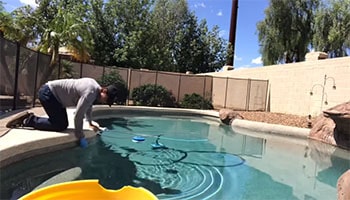
Use a putty knife, a pumice stone, or a hand-held wire brush to get all the spots you couldn’t get with the big brush. You can even use a chlorine tablet because not only does it have a scrubbing surface, but the chlorine gets applied chlorine directly to the bacteria. This kills its roots and prevents it from coming back.
To scrub with a chlorine tablet, you’ll need to wear chemical-resistant gloves and protective goggles. Break a three-inch tablet in half and hold it firmly while you scrub the bacteria with the broken edge.
If you can’t reach a spot, place one-half of the tablet in a chlorine tablet holder with the broken part facing outward. Attach the holder to your telescoping pole and scrub the formerly unreachable spots.
5. Quadruple Shock the Pool
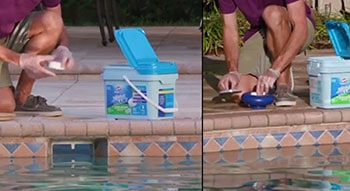
You’re going to quadruple shock your pool because a regular dose won’t be enough. See what the manufacturer says is the correct dose for your pool’s volume, and then multiply that by four.
Use calcium hypochlorite because nothing else on the market works as good as this substance for getting rid of black algae. Place all your pool maintenance equipment, such as the brush, the leaf skimmer, and the tablet holder, in the shallow end so it can be sanitized while you’re shocking your pool.
Remember to do your shocking at night. If you do it during the day, the sun’s rays will neutralize the chlorine before it has a chance to kill the bacteria.
6. Run the Pump
Run the pump for 24 hours, so the shock is dispersed evenly throughout the water. Of course, it’ll make the water cloudy, but that’s okay. Even if the pump has black algae in it, the shock should kill it off.
7. Brush the Pool
While the pump is running, scrub the surfaces at least two more times to eliminate any vestiges of black algae.
8. Clean the Filter
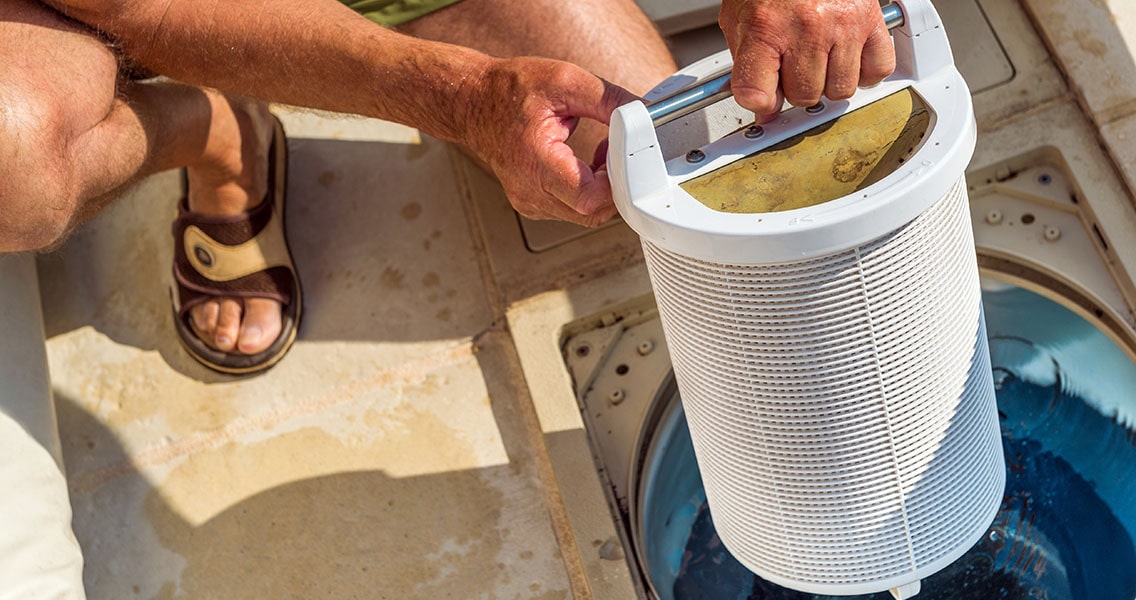
To clean the filter, use a filter cleaner to backwash your sand or DE filter.
9. Repeat the Process
If you still see vestiges of black algae, shock your pool again, run your pump for another 24 hours, and do some more brushing.
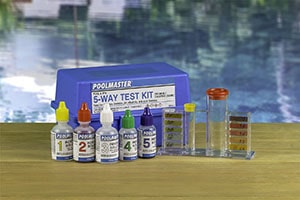
10. Test and Balance the Water
Once you no longer see any black algae, test the water. Add chemicals as needed to bring the levels up to where they should be. Over the next few weeks, keep a close eye on your pool to see if black algae reappears. If you see some, brush it away, scrub the area with a broken chlorine tablet, and then shock your pool (a standard dose will do).
Using Algaecides
Black algae defends itself from chemical attacks by producing a waxy coat that prevents chlorine or algaecides from penetrating. So if you’re going to use an algaecide to kill black algae, make sure it contains a penetrating agent. This way, the chemical will get past the waxy coat more effectively than chlorine will.
How To Stop Black Algae from Returning
The best way to stop the formation of black algae is to make sure there’s adequate circulation in your pool. Also, make it mandatory that anyone who swims in your pool rinses off first. All swimmers should wash their swimsuits, aquatic shoes, toys, and anything else before it goes into the water. Pool toys need to be scrubbed with a solution of one tablespoon of bleach per gallon of water. This will not only get them clean but will also sanitize them.
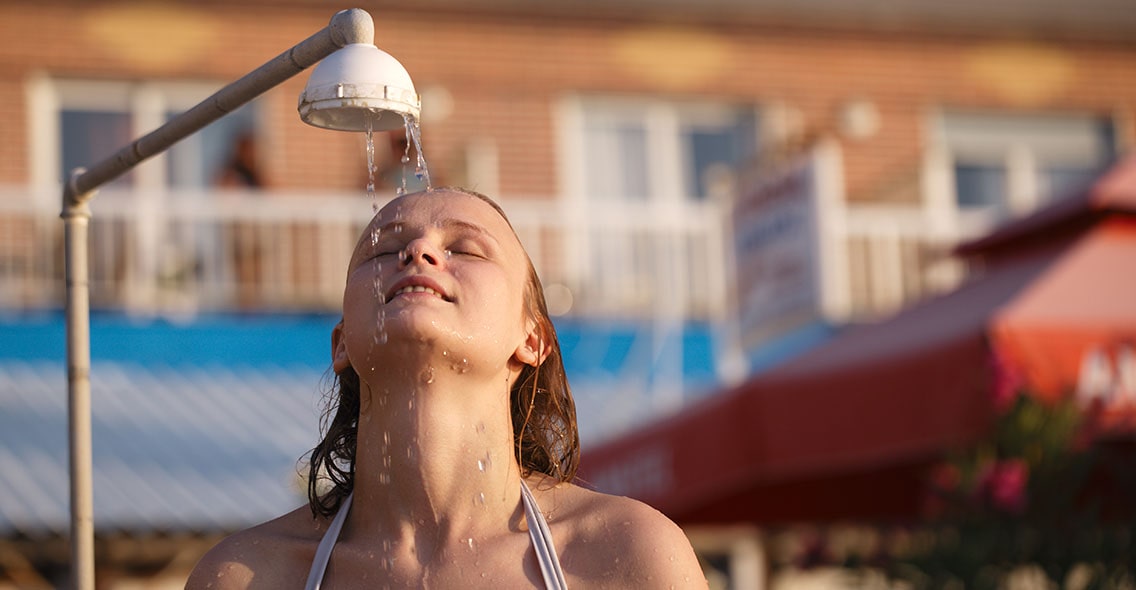
Swimsuits can go into the washing machine. However, the tiny bacterial spores stick to swimming wear fabric and jump into the pool the first chance they get, so make sure you use bleach to clean them.
Keeping your pool balanced and sanitized is another way you can keep nasty cyanobacteria from ruining the pristine clarity of your pool water. Shock your pool at least once a week. Run your pump and filter for eight to 12 hours a day for the duration of the season. Make sure your pool stays clean by regularly vacuuming and brushing it.
Closing Thoughts
Following the steps in this article will keep your family and pets safe from black algae, allowing you to enjoy the fun-filled delights of the warmer weather.If you need to get rid of green algae, check out our article on the subject. Have fun this summer, and happy swimming!

Pool Maintenance Tips & Tricks
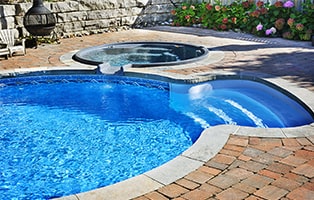

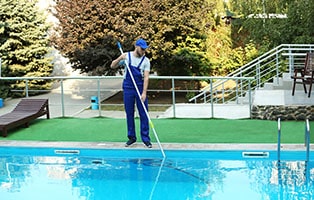
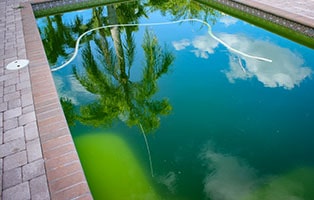
Thank you for a very informative article. I do have one question.
Since black algae needs to have its protective coating brushed off in order for chemicals to get to it to kill it, when cleaning filter cartridges, can you recommend a filter cleaner that can remove black algae from the cartridges without the coating being removed?
Thanks. I appreciate the pragmatic step-by-step approach. Black algae has taken over fully 30% of my pool walls and floors and your is the first tutorial I’ve found that gives me a path forward that, while grueling and somewhat expensive, seems to have a good chance of success. I don’t mind the work if I know I will see results. I especially like insights like “Use calcium hypochlorite because nothing else on the market works as good as this substance for getting rid of black algae. ” I’m assembling the chemicals and tools and will send you an update in a few weeks when I bite the bullet.
Excellent article. Having a saltwater pool installed soon and learning how to protect it. Is the process similar with a saltwater pool?
Brushing with the aluminum brush and quadruple shocking with calcium hypochlorite worked beautifully! Thanks so much!!!